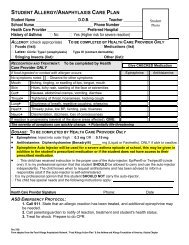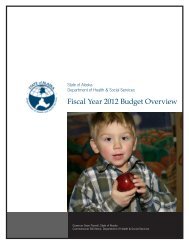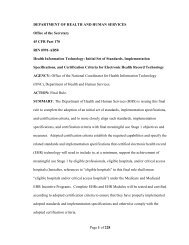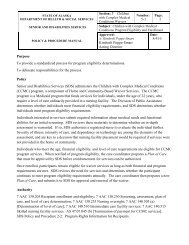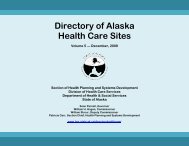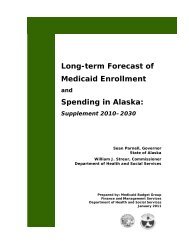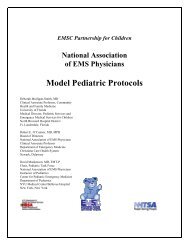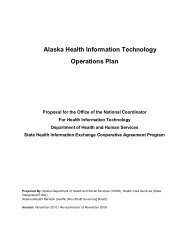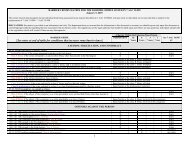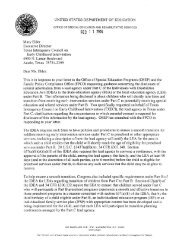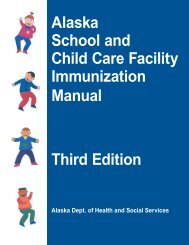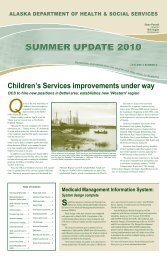Long-term Forecast of Medicaid Enrollment Spending in Alaska:
Long-term Forecast of Medicaid Enrollment Spending in Alaska:
Long-term Forecast of Medicaid Enrollment Spending in Alaska:
Create successful ePaper yourself
Turn your PDF publications into a flip-book with our unique Google optimized e-Paper software.
<strong>Enrollment</strong><br />
after 2019, the growth rate for children drops below that <strong>of</strong> the adults. Over the<br />
last five years, the growth rate for children becomes negative.<br />
Table 1: Elderly enrollment is projected to grow faster than other age<br />
groups<br />
MEDICAID ENROLLMENT BY AGE GROUP FOR SELECTED YEARS, 2009-2029<br />
Age Group 2009 2014 2019 2024 2029<br />
Average<br />
Annual<br />
Change<br />
Children (0-19) 84,512 90,440 94,552 95,408 94,233 0.6%<br />
Work<strong>in</strong>g Age<br />
Adults (20-64) 36,114 38,782 40,183 41,329 42,569 0.8%<br />
Elderly (65+) 8,270 11,054 14,766 18,860 22,336 5.1%<br />
Source: <strong>Medicaid</strong> Budget Group, MESA Model.<br />
Figure 4: <strong>Enrollment</strong> <strong>in</strong>creases are projected to be modest<br />
ENROLLMENT BY AGE GROUP<br />
<strong>Medicaid</strong> Enrollees<br />
180,000<br />
160,000<br />
140,000<br />
120,000<br />
100,000<br />
80,000<br />
60,000<br />
40,000<br />
20,000<br />
0<br />
Source: <strong>Medicaid</strong> Budget Group, MESA Model<br />
Actual Projected<br />
Children Work<strong>in</strong>g Age Elderly<br />
The demographic characteristics <strong>of</strong> <strong>Medicaid</strong> enrollees have changed and will<br />
cont<strong>in</strong>ue to do so <strong>in</strong> the future. The share <strong>of</strong> children as a percent <strong>of</strong> all<br />
participants enrolled <strong>in</strong> <strong>Medicaid</strong> <strong>in</strong>creased <strong>in</strong> the late 1990s and cont<strong>in</strong>ued to<br />
<strong>in</strong>crease <strong>in</strong> the beg<strong>in</strong>n<strong>in</strong>g <strong>of</strong> this decade until 2004, when they accounted for 67<br />
percent <strong>of</strong> enrollees. This co<strong>in</strong>cided with the <strong>in</strong>troduction <strong>of</strong> Denali KidCare,<br />
which expanded <strong>Medicaid</strong> to more pregnant women and <strong>in</strong>dividuals. From 2004<br />
to 2007, the household <strong>in</strong>come eligibility requirements for Denali KidCare were<br />
locked <strong>in</strong>to place <strong>in</strong>stead <strong>of</strong> be<strong>in</strong>g adjusted for <strong>in</strong>flation, so some <strong>in</strong>dividuals fell<br />
<strong>of</strong>f the rolls. The proportion <strong>of</strong> enrollees who are children has s<strong>in</strong>ce dropped to<br />
66 percent. With a 0.6 percent annual growth rate from 2009 to 2029, children’s<br />
<strong>Long</strong> Term <strong>Forecast</strong> <strong>of</strong> <strong>Medicaid</strong> <strong>Enrollment</strong> and <strong>Spend<strong>in</strong>g</strong> <strong>in</strong> <strong>Alaska</strong>: 2009‐2029<br />
9



